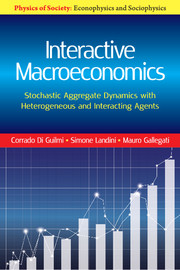2 - The State Space Notion
from Part I - Methodological Notes and Tools
Published online by Cambridge University Press: 23 July 2017
Summary
Introduction
The first notion to consider is the notion of system. Intuitively, a system can be defined as an assembly of parts, as a collective body, where each element does something in such a way that, all together, the parts cooperate to perform some kind of collective action or cause a macroscopic emergent phenomenon. From a complex systems perspective, a system is a collection of constituents dominated by intrinsic stochastic laws, due to the interactive behavior of heterogeneous parts, for every possible granularity of the description.
If the composition into parts is relevant, the system is the ensemble of subsystems, a macroscopic collective body of microscopic units which organize a hierarchical structure of mesoscopic subsystems. The granular composition of a macro-system is mainly relevant when the ensemble of micro-systems is dominated by heterogeneity and interaction inducing emergent phenomena which cannot be explained other than by following statistical reasonings and inferential methods, that is, phenomena taking place at the macroscopic level and for which the complete knowledge of the microscopic world is not enough.
For instance, assume that the system is a sector of economic activity in the economy and consider there are firms of different sizes, for example, small, medium and big firms. Three ensembles can be isolated, which are defined as subsystems. Although each of these groups is a collective body, none is as macro as the economy (the complex system) and none is as micro as the single firms (the elementary constituents). This is the mesoscopic perspective: between the very macro-system and the very micro-systems, there can be a wide spectrum of meso-systems.
Definition 2.1 A system is meant to be any kind of body characterizing the phenomenon under scrutiny. When explaining phenomena, the granular composition matters, as does heterogeneity and interaction. The (macro) system is an ensemble of (meso) subsystems, each made up of a large number of (micro) elementary constituents.
A system is therefore not an absolute notion; it involves a hierarchy of organized structures made up of constituents at lower levels of aggregation.
At the micro-, meso- and macro-level, observables can be conceived as (random) variables in space and time. Observables can be represented as a set of quantities, a family of measurable quantities on a system made of N observation units.
- Type
- Chapter
- Information
- Interactive MacroeconomicsStochastic Aggregate Dynamics with Heterogeneous and Interacting Agents, pp. 29 - 44Publisher: Cambridge University PressPrint publication year: 2016

